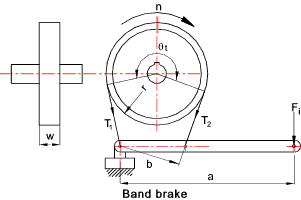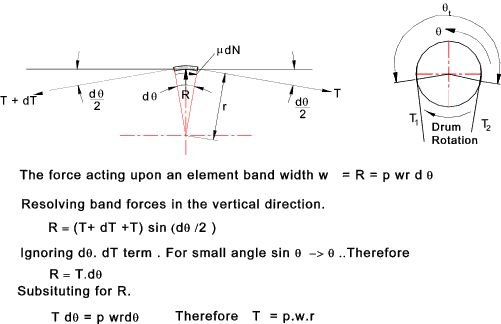Brakes
Band Brakes
|
Introduction This is a very simple type of brake using the principle that a band is wrapped
part round a rotating drum. Tension can be applied to the band using a lever.
The restraining torque results from the difference in tension between the two ends of the belt.
Band Brake The principles of operation of the band brake is the same as for belt drives.. refer
to information on page Flat Belt Drives
The tension due to the belt rotational inertia for Tc = 0 because the band is not moving for
the brake application. The relevant formula is therefore T1 /T2 = e μθ t
For the Normal Band Brake arrangement shown the relationship between the actuating force and the slack side belt tension is Fi = T2 . b /a Brake Torque CapacityThe torque capacity of the band brake = M = (T1 - T2 ) r Maximum Belt Tension
The maximum tension in a belt is provided by the formula below. T1_max = pmax.w.r Differential Band Brake The differential band brake as shown below can be configured to be self energising and can be arranged to operate in either direction..
The actuating force equation obtained by summing moments about the pivot points is shown below Fi = ( b 2 T 2 - b 1 T 1 ) / a If b 2 T 2 = b 1 T 1 the zero actuating force is required and the brake is self locking. It is also apparent that the brake is effectively free wheeling in the opposite direction. The differential brake can therefore be arranged to enable rotation in one direction only. |
Links to Brake Design
|
|
Brakes


